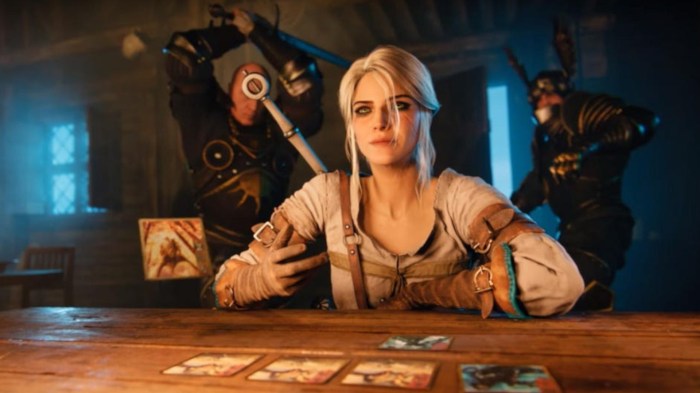Witcher 3 minigame Gwent trademarked sets the stage for this enthralling narrative, offering readers a glimpse into a story that is rich in detail and brimming with originality from the outset. Gwent, the beloved card game within The Witcher 3: Wild Hunt, has transcended its humble origins as a side activity to become a popular standalone game. CD Projekt RED, the game’s developer, recognized Gwent’s potential and made the strategic decision to trademark the name, solidifying its place in the gaming landscape.
This decision sparked a wave of curiosity and speculation among players, leading to questions about the future of Gwent and its potential for growth. The trademarking of “Gwent” is a testament to its enduring popularity and its impact on the gaming industry. This move has significant implications for Gwent’s development, as it ensures its exclusivity and protects its brand identity.
The Rise of Gwent: Witcher 3 Minigame Gwent Trademarked
Gwent, the card game featured in The Witcher 3: Wild Hunt, has become a phenomenon in its own right, evolving from a simple side activity to a beloved standalone game. Its journey from humble beginnings to widespread popularity is a testament to its engaging gameplay and dedicated community.
Origins in The Witcher 3: Wild Hunt
Gwent was initially introduced as a side activity in The Witcher 3: Wild Hunt, a role-playing game set in a fantasy world. Players could engage in Gwent matches with various characters encountered during their adventures. The game’s simple rules and strategic depth quickly captured the attention of players, who found themselves spending hours perfecting their Gwent decks and vying for victory.
Initial Reception and Popularity
The initial reception of Gwent among players was overwhelmingly positive. Many praised its intuitive gameplay, strategic depth, and charming aesthetic. The game’s popularity quickly grew, with players sharing their Gwent experiences online and discussing strategies in forums and communities. Gwent’s popularity within The Witcher 3: Wild Hunt was so significant that it sparked a demand for a standalone version.
Gwent’s Evolution to a Standalone Game, Witcher 3 minigame gwent trademarked
CD Projekt Red, the developers of The Witcher 3: Wild Hunt, recognized the potential of Gwent and decided to create a standalone version of the game. This decision was driven by the overwhelming popularity of Gwent within The Witcher 3 and the desire to provide players with a dedicated and expanded experience. Gwent was released as a standalone game in 2017, and it quickly gained a dedicated following, becoming one of the most popular card games on the market.
Gwent’s Future and Potential
Gwent, the popular card game within The Witcher 3: Wild Hunt, has captivated players with its strategic depth and unique gameplay. Its success has led to a standalone release, expanding its reach and establishing a dedicated community. With its potential for growth, Gwent’s future holds exciting possibilities.
Gwent’s Potential as a Competitive Esports Game
Gwent possesses the core elements needed to flourish as a competitive esports game. Its strategic depth, emphasis on skill and decision-making, and the potential for diverse deck building strategies make it a compelling platform for competitive play.
- High Skill Ceiling: Gwent requires players to master complex card interactions, resource management, and strategic decision-making. This high skill ceiling creates a dynamic and engaging competitive environment, allowing for skill-based competition and rewarding mastery.
- Diverse Deck Building: The wide array of cards and factions in Gwent enables players to craft unique and effective decks. This diversity fosters creativity and strategic experimentation, making each match a unique challenge.
- Spectator-Friendly Gameplay: Gwent’s gameplay is easy to understand and follow, even for those unfamiliar with the game. This spectator-friendly nature allows for engaging tournaments and broadcasts, attracting a broader audience.
Examples like Hearthstone and Legends of Runeterra, both successful card games with thriving esports scenes, demonstrate the potential for Gwent to establish itself as a competitive esports game. The key lies in fostering a supportive ecosystem with dedicated tournaments, sponsorships, and community engagement.
Final Review
The story of Gwent is a testament to the power of a well-designed minigame to capture the hearts of players and evolve into a thriving standalone game. From its humble beginnings as a side activity in The Witcher 3, Gwent has grown into a popular card game with a dedicated community and a bright future. CD Projekt RED’s decision to trademark “Gwent” reflects the game’s enduring appeal and its potential for continued success. As Gwent continues to evolve and expand, it will undoubtedly leave a lasting impact on the gaming industry.
The popularity of Gwent, the card game featured in The Witcher 3, has led to its trademarking, highlighting the game’s cultural impact. It’s interesting to see how intellectual property is handled in gaming, particularly in comparison to situations like fallout 4 pc mods being stolen for xbox one , where content creators face challenges in protecting their work.
While Gwent has been commercially successful, the trademarking of a minigame emphasizes the potential value of even seemingly small aspects of gaming experiences.
 Securesion Berita Informatif Terbaru
Securesion Berita Informatif Terbaru
